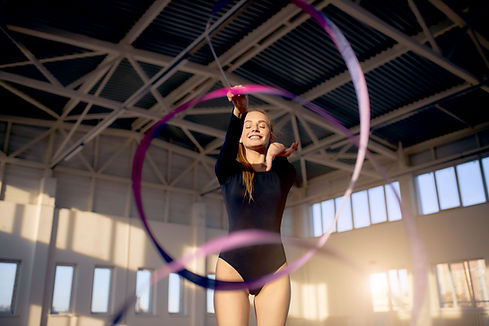About Rhythmic Gymnastics

History of Rhythmic Gymnastics
Rhythmic Gymnastics combines dance, ballet, and acrobatics with the skilful handling of apparatus such as rope, hoop, ball, clubs, and ribbon. Performed to music, it celebrates grace, strength, and artistry.
The sport began in early 20th-century Europe, inspired by ballet and free movement exercises. By the 1930s, apparatus were introduced, adding new creative and technical dimensions.
Rhythmic Gymnastics was officially recognised by the International Gymnastics Federation (FIG) in 1961, with the first World Championships held in 1963. It made its Olympic debut at the 1984 Los Angeles Games for individuals, and in 1996, the group competition was added. Today, rhythmic gymnastics is practiced worldwide, with athletes pushing the boundaries of flexibility, coordination, and performance.
In Australia, the sport continues to grow, with gymnasts achieving success at Commonwealth Games, World Championships, and the Olympics from our very own Alexandra Kiroi-Bogatyreva— inspiring the next generation to perform with elegance and passion.
Rhythmic Gymnastics Apparatus

Rope
The rope is traditionally made of hemp or synthetic materials, with length tailored to the gymnast’s height. It’s used for skipping, jumps, swings, figure-eights, and more.
Historically one of the original FIG recognised apparatuses alongside hoop and ball it has since been phased out of senior individual events but still appears in junior group routines.

Hoop
Made of plastic or wood, with an inner diameter of 80–90 cm and a minimum weight of 300g.
Hoop routines include rolls, rotations around the hand or body, passing through, swings, throws, and catches. The hoop’s circular shape encourages large, sweeping movements and dramatic floor patterns.

Ball
Made of rubber or synthetic material, the ball is smooth, 18–20 cm in diameter, and must weigh at least 400g.
Routines showcase rolling the ball across the body, bouncing, throwing, catching, and balancing all while maintaining fluid, continuous movement. The ball highlights grace, body control, and seamless integration with dance elements.

Ribbon
A 6 m (senior) or 5 m (junior) satin ribbon attached to a stick (50–60 cm). Routines feature spirals, snakes, swings, throws, and big figure-eight movements.
The ribbon creates continuous, flowing patterns and requires constant motion to avoid tangling. It highlights artistry, musicality, and expression.

Clubs
A pair of small, tapered batons (each 40–50 cm long, weighing at least 150g), usually made of wood or synthetic material.
Club routines feature intricate mills, swings, tapping, asymmetric movements, throws, and catches. They demand high precision, ambidexterity, and rhythm.

Freehand
Also known as floor exercise (FX) in rhythmic gymnastics, this involves pure body movement without apparatus.
Routines rely on leaps, balances, pivots, and dance steps to interpret the music. Freehand highlights the gymnast’s artistry, expression, and technical fundamentals, and is mainly used in younger age categories and beginner competitions.
Benefits of Rhythmic Gymnastics
Rhythmic gymnastics is more than just a beautiful sport, it’s a complete blend of athletic skill, artistry, and self-expression. It develops both the body and the mind, making it an ideal activity for children and adults alike.
Healthy, Active Bodies
-
Improves strength, flexibility, and posture
-
Builds balance, agility, and coordination
-
Boosts overall fitness and stamina
Growing Confident Minds
-
Encourages focus, discipline, and goal setting
-
Builds confidence through performances and achievements
-
Inspires creativity and self-expression with music and movement
Friendship & Life Skills
-
Teaches teamwork and how to support others
-
Builds resilience and a positive attitude toward challenges
-
Encourages sportsmanship and respect for others

Australian RG Achievements
1994
Leigh Marning
Commonwealth Games
Team silver & individual medals
1998
Leigh Marning
Commonwealth Games
Team & individual medals
1999
Bree Robertson
Julietta Shishmanova GP
First Aussie medallist in Europe
2000
Bree Robertson
Commonwealth Youth Games
Multiple medals
2010
Naazmi Johnston
Commonwealth Games
All-around & ball gold, ribbon & rope silver, team gold
2016
Danielle Prince
Olympics (Rio)
Australian individual participant
2018
Alexandra Kiroi-Bogatyreva
Commonwealth Games
Bronze in ball
2018
Kiroi-Bogatyreva, Price, Sung
Commonwealth Games
Team bronze
2020
Tokyo Olympic Group
Olympics (Tokyo)
First-ever Australian Olympic rhythmic group
2020
Lidiia Iakovleva
Olympics (Tokyo)
Competed individually
2022
Kiroi-Bogatyreva, Iakovleva, Gill
Commonwealth Games
Team silver
2022
Alexandra Kiroi-Bogatyreva
Commonwealth Games
All-around bronze & clubs gold
2024
Australian Group
Olympics (Paris)
Second Australian group to compete in Olympics
2024
Alexandra Kiroi-Bogatyreva
Olympics (Paris)
Matched 2nd-highest individual all-around finish (22nd)
2025
Alicia Tan
Junior World Championships
First Australian to reach apparatus final
